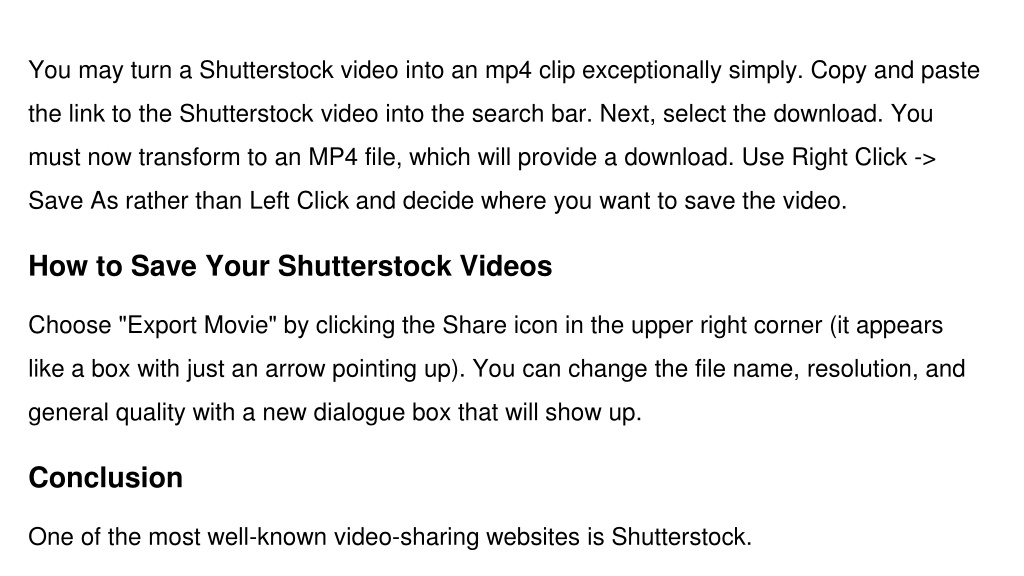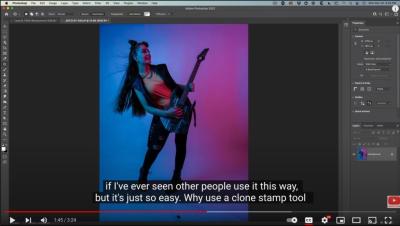Creating compelling content is exciting, but it’s super important to do so ethically and legally. Using footage from platforms like Shutterstock can be a great resource, but only if you understand how to use it properly. In this post, I’ll walk you through how to ethically rip footage from Shutterstock—meaning, how to use it without stepping on anyone’s toes or breaking copyright laws. Think of it as playing by the rules while still getting the visuals you need to make your project shine. Let’s dive into why respecting copyright and understanding licensing is so crucial for content creators like you!
Understanding Shutterstock Licensing and Usage Rights

Before you start downloading or “ripping” footage from Shutterstock, it’s essential to get a clear picture of what your license actually allows. Shutterstock offers different types of licenses, mainly Standard and Enhanced, each with its own set of rights and restrictions. Here’s a quick breakdown:
- Standard License: Ideal for most online projects, such as websites, social media, and presentations. It typically allows you to use footage in up to 500,000 copies or views. However, there are restrictions—like no use in merchandise or items for resale, and not for broadcast TV shows or films.
- Enhanced License: Offers broader rights, including unlimited views, use in merchandise, and broadcast projects. This license is better if you plan to use footage in commercial products or larger audiences.
To ethically use footage from Shutterstock, you need to:
- Purchase the appropriate license for your project’s scope and distribution.
- Respect the license terms—avoid using footage in ways that are explicitly restricted.
- Keep proper records of your license purchase and usage rights.
Remember, downloading footage without a license or beyond the license’s scope is considered copyright infringement, which can lead to legal issues. Always verify your license and adhere to its terms. If you’re unsure, consult Shutterstock’s licensing FAQs or contact their support to clarify what you can and cannot do with the footage. Being diligent about licensing not only keeps you on the right side of the law but also respects the creators who produce these visuals. So, always choose the right license and use the footage ethically to ensure your project remains compliant and respectful of copyright laws.
Legal Ways to Download and Use Shutterstock Footage

When it comes to using footage from Shutterstock, the most important thing is to stay on the right side of the law. Thankfully, Shutterstock makes it pretty straightforward to access their content legally, as long as you follow their licensing agreements. Let’s explore the proper ways to download and utilize footage from
First off, you’ll want to purchase the appropriate license. Shutterstock offers different licensing options, primarily Standard and Extended licenses. The Standard license is suitable for most uses like online videos, social media, and presentations. If you’re planning to use footage in a product for resale or in a large commercial project, an Extended license might be necessary. Always read the licensing terms carefully to ensure you’re compliant.
Here are the steps to legally obtain and use Shutterstock footage:
- Create an account: Sign up on Shutterstock’s website to access their library and purchase licenses.
- Select the footage: Use their search tools, filters, and categories to find the perfect clips for your project.
- Purchase the appropriate license: Choose the license type based on your intended use. You can buy credits or subscribe to a plan for regular access.
- Download the footage: Once purchased, download the high-quality files directly from Shutterstock. They provide files in various formats and resolutions.
- Use the footage within licensing terms: Incorporate the downloaded content into your projects, ensuring you adhere to the license restrictions—like not redistributing the raw footage on its own or using it in a way that violates the license.
It’s also a good idea to keep records of your licenses and downloads. This way, if any questions arise later, you can demonstrate that you’ve legally acquired the footage. Remember, respecting licensing agreements not only keeps you compliant but also supports content creators who work hard to produce quality footage.
Common Mistakes to Avoid When Ripping Footage from Shutterstock
Even with the best intentions, people sometimes stumble into legal pitfalls or technical issues when working with Shutterstock footage. To help you navigate this smoothly, here are some common mistakes to steer clear of:
1. Using Footage Without Proper Licensing
This is the biggest no-no. Downloading footage without purchasing the correct license or attempting to rip footage through unauthorized means can lead to serious legal trouble. Always ensure you have an active license before using any footage in your project.
2. Ignoring License Restrictions
Each license comes with specific restrictions—like usage limits, geographic restrictions, or prohibitions on redistribution. Ignoring these can result in copyright infringement. For example, using footage licensed for online use in a TV commercial without upgrading to an extended license could backfire.
3. Ripping Footage via Unofficial Methods
Trying to download or extract footage through hacks, third-party tools, or browser extensions not authorized by Shutterstock is risky. Not only can this lead to legal issues, but it also exposes your device to malware. Stick to legitimate download options provided by Shutterstock.
4. Failing to Keep Documentation
Always save your licensing agreements, receipts, and download records. These serve as proof of legal use if your project is ever questioned. Lack of documentation can make it difficult to defend your rights if challenged.
5. Overlooking the Need for Proper Attribution (When Required)
Some licenses or specific content might require attribution. Make sure you understand whether attribution is necessary and include the proper credits in your project. Failing to do so can violate license terms.
6. Using Footage in Inappropriate Contexts
Even if you have the license, avoid using footage in contexts that could be misleading, defamatory, or harmful. Always respect the rights of the content creators and the subjects featured in the footage.
By being mindful of these common pitfalls, you can enjoy Shutterstock footage confidently and ethically. Remember, respecting licensing terms not only keeps your projects safe but also supports the creative community that makes all this amazing content possible.
Alternatives to Ripping Footage Ethically and Legally
Let’s be real — while it might seem tempting to find quick ways to get footage from Shutterstock, it’s always best to stick to ethical and legal methods. Not only does this protect you from potential legal trouble, but it also supports the hardworking creators behind the content. So, what are some legitimate alternatives to ripping footage? Here are a few options that keep everything above board:
1. Purchase or Subscribe for Licensed Content
The most straightforward way is to buy or subscribe directly through Shutterstock. They offer flexible plans — from single image/video purchases to monthly subscriptions. When you pay for licensed content, you get the right to use it according to the license agreement. This way, you’re respecting the rights of creators and staying on the right side of copyright laws.
2. Use Shutterstock’s Download Options
If you have an active subscription, simply download the footage directly from your Shutterstock account. This guarantees you’re getting high-quality files legally, with proper licensing rights. Plus, you can choose the format and resolution you need, making your workflow smooth and legal.
3. Explore Royalty-Free or Creative Commons Footage
There are platforms offering royalty-free or Creative Commons-licensed videos that you can legally use after giving proper credit. Websites like Pexels, Unsplash, or Pixabay provide free footage you can incorporate into your projects without worry. Just be sure to read and follow the licensing terms for each piece.
4. Reach Out for Permission
If you find footage you love but it’s not openly available for download, consider reaching out to the creator or copyright holder. Many creators are happy to grant permission or offer licensing options if you ask politely and explain your intended use. This approach fosters good relationships and keeps everything transparent.
5. Create Your Own Content
When in doubt, why not produce your own footage? Even simple videos shot with a smartphone can add a personal touch to your project. Plus, this guarantees you have full rights to your content and avoids any legal gray areas.
In summary, the key is to respect the rights of content creators and use legitimate channels. Not only does this keep you out of trouble, but it also supports the creative community that makes all this content possible. Remember, ethical and legal choices aren’t just about avoiding problems—they’re about contributing positively to the creative ecosystem we all enjoy.
Conclusion and Best Practices for Respecting Content Creators
Wrapping things up, it’s clear that handling footage ethically and legally isn’t just a technical detail—it’s a matter of integrity and respect. Creators invest time, skill, and passion into their work, and honoring their rights helps sustain a vibrant, innovative content landscape.
Here are some best practices to keep in mind:
- Always use licensed content obtained through official channels like Shutterstock, Adobe Stock, or other reputable providers.
- Read and understand licensing agreements before downloading or using footage. Know what’s allowed and what’s not.
- Give credit when required for Creative Commons or royalty-free footage that stipulates attribution.
- Avoid ripping or pirating content — it’s illegal and undermines the hard work of creators.
- Support creators by purchasing or subscribing rather than seeking unauthorized copies.
- Explore alternative resources like free stock footage sites or consider creating your own content.
By following these guidelines, you’re not only protecting yourself from legal issues but also contributing to a fair and respectful creative community. Remember, every piece of content you use has a story behind it, and honoring that story makes your projects all the more meaningful. Let’s keep the internet a place where creativity thrives, ethically and legally.


